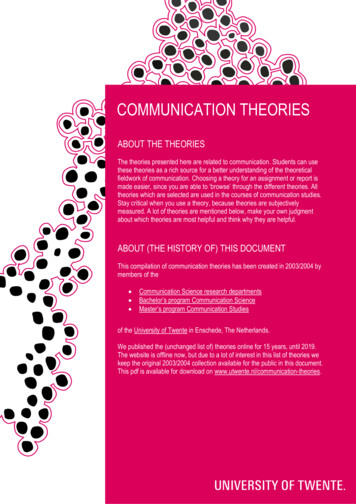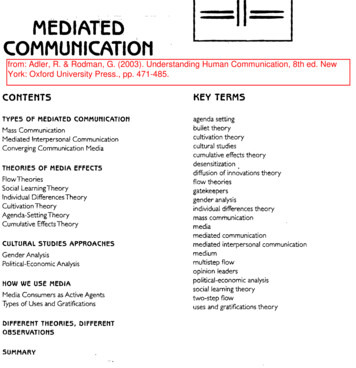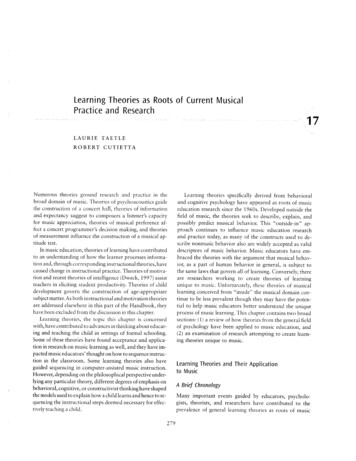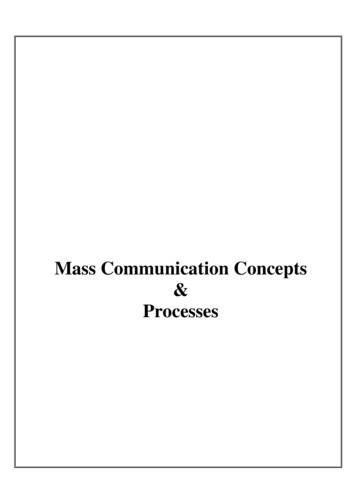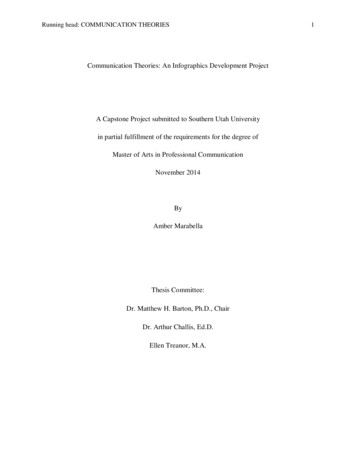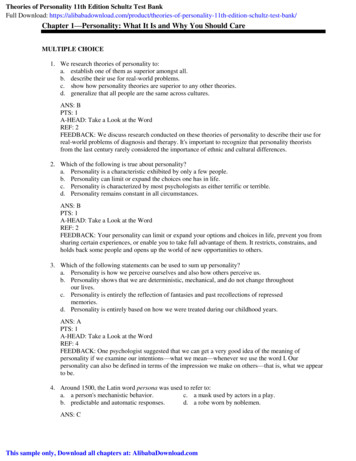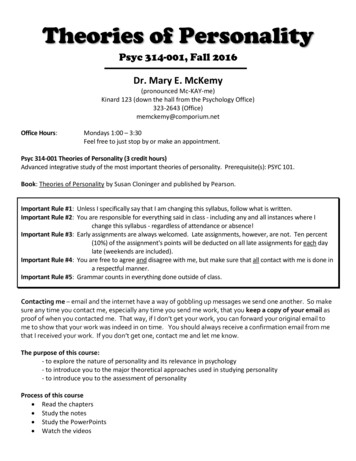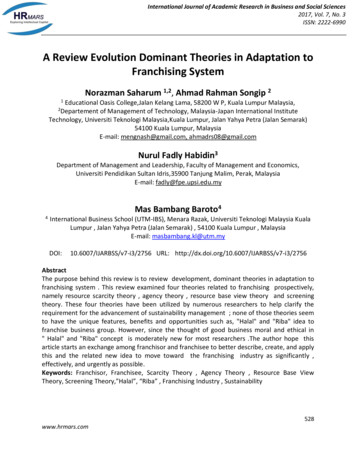
Transcription
International Journal of Academic Research in Business and Social Sciences2017, Vol. 7, No. 3ISSN: 2222-6990A Review Evolution Dominant Theories in Adaptation toFranchising SystemNorazman Saharum 1,2, Ahmad Rahman Songip 21Educational Oasis College,Jalan Kelang Lama, 58200 W P, Kuala Lumpur Malaysia,of Management of Technology, Malaysia-Japan International InstituteTechnology, Universiti Teknologi Malaysia,Kuala Lumpur, Jalan Yahya Petra (Jalan Semarak)54100 Kuala Lumpur, MalaysiaE-mail: mengnash@gmail.com, ahmadrs08@gmail.com2DepartementNurul Fadly Habidin3Department of Management and Leadership, Faculty of Management and Economics,Universiti Pendidikan Sultan Idris,35900 Tanjung Malim, Perak, MalaysiaE-mail: fadly@fpe.upsi.edu.myMas Bambang Baroto44International Business School (UTM-IBS), Menara Razak, Universiti Teknologi Malaysia KualaLumpur , Jalan Yahya Petra (Jalan Semarak) , 54100 Kuala Lumpur , MalaysiaE-mail: masbambang.kl@utm.myDOI:10.6007/IJARBSS/v7-i3/2756 URL: ctThe purpose behind this review is to review development, dominant theories in adaptation tofranchising system . This review examined four theories related to franchising prospectively,namely resource scarcity theory , agency theory , resource base view theory and screeningtheory. These four theories have been utilized by numerous researchers to help clarify therequirement for the advancement of sustainability management ; none of those theories seemto have the unique features, benefits and opportunities such as, "Halal" and "Riba" idea tofranchise business group. However, since the thought of good business moral and ethical in" Halal" and "Riba" concept is moderately new for most researchers .The author hope thisarticle starts an exchange among franchisor and franchisee to better describe, create, and applythis and the related new idea to move toward the franchising industry as significantly ,effectively, and urgently as possible.Keywords: Franchisor, Franchisee, Scarcity Theory , Agency Theory , Resource Base ViewTheory, Screening Theory,”Halal”, “Riba” , Franchising Industry , Sustainability528www.hrmars.com
International Journal of Academic Research in Business and Social Sciences2017, Vol. 7, No. 3ISSN: 2222-69901.0 INTRODUCTIONThe paper starts with a concise of the review, evolution dominant theories of franchising . Thisreview adds to the writing by investigating these with regards to franchised organization . Thediscoveries from an arrangement theories are then introduced . At last the consequences of thediscoveries are discussed.(Watson, 2008)Business has been one of the most interesting and economical jobs in the world. The world hadwitnessed that with business, it can conquer the economy and the world. It has been affectingour lives, such in lifestyle, family economy, our routines and social. Business is a wide aspect tobe considered in this paper. We should understand that in business it has entrepreneurship,which make business is a serious job. With entrepreneurship activity going wild all around theworld, born entrepreneurs that running down the business.In entrepreneurship, franchising, business is one of its kind in a business world. In the business,exist franchisor and franchisee. This term has it's own typical system format, Franchisor refersto a company or an individual who give chances to the Franchisee to engage in their developedbusiness, but followed their own regulations such as trademark, brand names, regulations andthe provision of intangible assets (Hunt,1997). In a bigger vision, Franchisor had the authoritiesto eliminate its franchises as they had the right. The franchisor also manages the standards,decide the performance level, the economic efficiencies of the company and misuse royalties(Baucus et al., 1993).Franchisor-Franchisee relationship plays a major role in entrepreneurship business. The systemrequired a successful relationship to lead to a well-being business that the two sides weredoing. These individual relationships are constructed while acting on the franchising industryand effect the company growth outcomes. It also shows a relationship, trust and improvedbusiness quality between these two sides, franchisor and franchisee (Dant, R. P., Weaven, S. K.,& Baker, B. L. (2013).As franchising industry required a high level of trust and commitment to the individual. A goodrelationship between individuals can sustain a long term in aspects of the business relationship.To conceptualize this two term, relationship commitment is defined as a much hard workrequired to comply the business by ongoing relationship between individuals, franchisor andfranchisee, seems important (Morgan and Hunt, 1994). A bad decision- making processbetween these two sides can bring frustration either by franchisor nor franchisee. Muchliterature has been doing research on the failure of these two individuals and the factors thatcontribute to it without considering the aspects of frustration between this both individuals.So, in this paper, research has been done towards revolution dominant theories of franchising .It also discussed in each theories the relationship process between the franchisor andfranchisee commitment in the franchising system as a successful business. From the varioustheories , we then consider the applicability of resource scarcity theories, resource base view529www.hrmars.com
International Journal of Academic Research in Business and Social Sciences2017, Vol. 7, No. 3ISSN: 2222-6990theories , agency theories and screening theories . Finally , we suggest directions for futureresearch and consider the implication of our study related to franchising system .2.0 PROBLEM STATEMENTThe impact of franchisor issue and disappointment on franchises is givng off an impression ofbeing possibly genuine on a franchisee and the normal proportion of franchisors to franchises,all in all, predicts that this earnestness will be copied many circumstances over. The impact offranchisor disappointment is to aggravate by the non appearance of security that the franchiseehas through the franchise assention, common law and statute. Regardless of the way that theimpact of franchisor dissatisfaction can be extraordinary and honest to goodness security in thefranchisee's business confined, the franchisee can now and again execute some carefultechniques to avoid or decrease the full effect of a drawing nearer or certifiable franchisordisappointment. (Buchan, Frazer, Qu, and Nicholls, 2015).Shane (1996) in his study of the failure of a franchise business has found 58 percent offranchisors fail within five years and 75 percent fail within ten years. Supported with findings bysome scientists in the franchise business that found when poor quality of the franchiserelationship between franchises and franchisors can lead to conflict and cause failure in thefranchise business (Frazer & Weaven, 2002; Weaven, Frazer, & Giddings, 2010) .Even in the study of Frazer et al., (2002), has been proved by 19 percent of franchisorsinvolved in the dispute is its harmonious relationship between the franchisor and thefranchises. Besides, taking care of issues in a convenient way is a critical characteristic offranchisor dependability, as "these are connections that are practically organized to createconflict, instead of diminishing conflict" (Franchising specialist). Conflict can show itself fromvarious perspectives, once in a while, growing into significant question took after by suit. Thiscircumstance was suitably depicted by one franchising mediator as turning into "somewhat likea cloud around them", whereby franchises and franchisors can get so made up for lost time inthe contention that they neglect to determine the issue. (Boulay et al 2016 ; Amy ,Mohd, Hoe,Hani, & Noor, 2011)The execution of the franchise system isn’t just relying on upon the individual abilities offranchisor and franchisee, additionally problem in the working relationship amongst franchisorand franchisee. This problem concentrates on the impacts of franchisee perceived relationshipquality and franchises' competencies on franchises' business accomplishment. In this review, itis additionally guessed that franchisee organizations, would be influenced by the dynamic . Ifthe franchisee perceived value of this agreement is imbalanced, disappointment, conflict andpoor execution could ensue.Thus, understanding relationship esteem as observed by thefranchisee and suggestions on both behavioral and goal franchise exhibitions is important.(Harmon and Griffiths, 2008) .The part of both parties is essential to accomplishing sustainableprofitability . The franchisor sets execution models and administers trademark and financialefficiencies, and can end the franchising, drive franchises purchase data sources, and abuse530www.hrmars.com
International Journal of Academic Research in Business and Social Sciences2017, Vol. 7, No. 3ISSN: 2222-6990powers. Franchises need battle with the limitations of the franchisor controls, legitimatelyrestricting determination and costs identified with franchising system, and consent to pay out atouch of advantages as base charges and eminences (Altinay, Brookes, Yeung, and Aktas, 2014 ;Baucus et al.,1993)The franchisee could implement to remain sustained some cautious systems to maintain astrategic distance from the full impact of coming or real franchisor disappointment . Such as,the amount of franchises at the time of the franchisor disappointment is regularly an underrepresentation of franchises influenced by the disappointment the same number of could haveeffectively left the system , frustrated at the nonappearance of franchisor support ,moderatestock deliveries , or distinctive issues indicative of the moving toward business disappointmentof the franchisor . For instance, a submitted beat direction does not "keep going forever" andthe issue of managing change decays to the expert structure. Furthermore, franchises as well astheir expert advisors (i.e., lawyer ,accountant, and franchise specialists) will be unable toanticipate the future dissolvability of the franchisor.(Aitkin,2012; Smith & Sharicz, 2011)3.0 LITERATURE REVIEWFranchising as an authoritative shape has mainly been clarified utilizing four theoreticalviewpoints, specifically from resource scarcity theory , agency theory , resource base viewtheory and screening theory. Resource scarcity theory proposes that franchising is utilized as amethod for conquering asset requirements, specifically budgetary and human capital (Norton,1988). Agency theory concentrates on issues relating to advantage and control within theprincipal/agent (Brickely&Dark, 1987). The resource base view theory focuses on issues,identify opportunities for better utilization in term of resource and capabilities and screeningtheory focuses on issues explanation of royalties, fees and specific investment attractingcompetent towards the franchising system. (Kirby& Watson ,1999 ; Combs, Michael, andCastrogiovanni, 2004).These viewpoints are similarly helpful in comprehension the difficulties confronting privatecompanies who attempt to grow geologically. Resource constraint , and financial , has beenobserved to be one of the best hindrances to little firm development (Hall, 1989). Barringer andGreening (1998) recommend that the successful administration of geographic development toweaken advantage is a specific test for independent venture development. Notwithstanding,recommended franchising can be viewed as a method for beating both asset and organizationconsiderations, it carries with its own difficulties. Along these lines, the difficulties forindependent venture development with regards to franchised associations is applicable.The rule duties of this review are firstly toward a progression of entrepreneurial franchiseetheory. Regardless of the way that the decision of sensible franchises is thought to be thefranchisor's single most unavoidable working issue (Jambulingam and Nevin, 1999), it has byand large been an under research territory (Altinay and Okumus, 2010; Clarkin and Swavely,2006; Wang and Altinay, 2008). Subsequently, "little theory has been created about how531www.hrmars.com
International Journal of Academic Research in Business and Social Sciences2017, Vol. 7, No. 3ISSN: 2222-6990franchises are picked" (Combs et al., 2011). The present review fills this void in the academicwriting by outlining the authoritative character calculates that effect franchisors to pick,especially franchising that have the abilities to take an interest in entrepreneurial exercises.Besides, our utilization of hierarchical character theories become the hypothetical point of viewused as a part of the franchising literature beyond the four dominant historical theories whichare resource scarcity theory , agency theory , resource base view theory and screening theory(see, for example Combs, Michael, and Castrogiovanni, 2009; Combs et al., 2011). Furthemore ,the evolution dominant theory in the franchising setting has been obliged (Dada and Watson,2013a; Zachary et al., 2011; Lawrence and Kaufman,2011) under research range (Altinay andOkumus, 2010; Clarkin and Swavely, 2006; Wang and Altinay, 2008)Subsequently, "little theory has been produced about how establishments are picked" (Combset al., 2011). The present review fills this void in the academic writing by outlining theauthoritative character that effect franchisors to pick especially franchises that have theabilities to take an interest in entrepreneurial activities. Moreover, our utilization ofauthoritative franchising hypothesis addresses the theoretical point of view of view used as apart of the franchising literature beyond the four predominant historical theories , resourcescarcity theory , agency theory , resource base view theory and screening theory (see, forinstance Combs, Michael, and Castrogiovanni, 2009; Combs et al., 2011). Moreover , so far,research investigating the identity theory in the franchising setting has been obliged (Dada andWatson, 2013a; Zachary et al., 2011; Lawrence and Kaufmann, 2011).This evolution theory offranchising can be shown in Table 3.0532www.hrmars.com
International Journal of Academic Research in Business and Social Sciences2017, Vol. 7, No. 3ISSN: 2222-6990Table 3.0. Evolution Dominant Theory of franchising .4.0 IMPLICATION FOR PRACTICEA franchise chain regularly acquires its reputation in view of successfully standardizing andimitating the chain's franchising systems, and this reputation can give the chain's outlets an animprovement over competitors in their local markets (Castrogiovanni and Kidwell, 2010). Thismay recommend that the determination of an entrepreneurial franchise can be inconsistentwith the institutionalization required in a franchised business environment.However, the franchisor's craving for standardization regularly conflicts with the requirementfor adaptations and entrepreneurial practices in the franchisee's nearby outlets, given thegeographically diverse nature of franchisees' business sectors (Cox and Mason, 2007; Pizantiand Lerner, 2003). The business environment for franchising operations has likewise turned outto be exceptionally aggressive, encountering fast changes, perhaps getting to be distinctly lesssecure than in past circumstances (Falbe et al., 1998). These progressions, alongside recentevidence recommending the vital part of franchisee entrepreneurial practice on the franchisesystem as a whole (e.g. Dada et al., 2012), may signal the need to combine entrepreneurialvalues within the standardized context of the franchise system .533www.hrmars.com
International Journal of Academic Research in Business and Social Sciences2017, Vol. 7, No. 3ISSN: 2222-69905.0 IMPLICATION FOR THEORYIndeed , potential franchises likely need some data or information , paying little attention towhether an organization or industry in nature, before they are even seen as a reasonablecandidate. This learning, notwithstanding what franchises experience after they transform intoa part of the chain, assembles franchises' chances to get the rewards of building up the amountof units they guarantee. Besides, the evidence prescribes that multiunit franchises arearranged to utilize their understanding over their units, along these lines, giving a level ofstandardization and consistency that can spread over the entire chain. From the franchisors'standpoint, this knowledge sharing may enhance efficiency because of their workload falls,and, meanwhile, franchisors have a level of affirmation that the learning granted is most likelygoing to be unsurprising to the affiliation's standards.(Gillis, Mcewan, Crook, & Michael, 2011)More generally, it is possible that franchisors utilize rivalries to reward franchises who can helpin the advancement of transfer of knowledge over the chain. To the degree that learning iscreated and transferred, it ought to upgrade execution. Future research seems to require thatlooks at how franchises contribute information to the chain and how that learning, thusly,impacts firm execution. Theory involves information, knowledge, learning, and capacities, forexample, the social view (Dyer and Singh,1998), would help our understanding in these fields.In our view, the utilization of numerous alliance partners (agents) with a larger (principal) firm,for example, in agency theory , would allow the principal firm to run the alliance portfolio as acompetition. For instance , these outcomes may have suggestions for store networkmanagement researchers exploring how firms utilize various cooperation accomplices in acompetition to decide contract victors.At last, one would also expect that franchisors would require the capacity to substitute amongincentive systems. For instance, a quickly developing chain may discover the guarantee of extraunits a simple incentive to use for new franchises and consequently would reduce otherincentive , for example, in screening theory . However , when growth slows, an alteration mightbe required to change to another incentive, for example, reducing the royalty fees when salesexceed objective range. Hence, when chains can't guarantee a moment or third unit to allowfranchises to use their administrative capital, different incentives or remuneration might berequired. Given the way of our information, we can't examine how this remuneration maychange over time, yet this may be a productive region of request for future longitudinal studies(Gillis et al., 2011)6.0 CONCLUSION AND RECOMMENDATIONAccording to researches , Dada et al 2012 ; Ketchen et al 2011 concluded that “Despite the factthat franchising keeps on being a critical plan of action globally, the issue of adaptationtheories in franchising has been predominant open deliberation among both academics andspecialists”. This review has demonstrated that the respected charisma of the franchisingsystem is important to building up a theory of franchising selectivity in franchisee recruitment(Tracey & Jarvis, 2007 ; Seawright et al., 2011534www.hrmars.com
International Journal of Academic Research in Business and Social Sciences2017, Vol. 7, No. 3ISSN: 2222-6990Generally ,from the four theories that have been reviewed originated came from westernideas, particularly concentrate on development , economic , monetary terms , fulfill assets ,expert and commercialization . Future research ought to center consideration around how tomaintain and sustained practice can be legitimized, operation, exchange needs to earn a valid "Halal" guarantee that all work include is in good ethic and good moral . Moreover giveconsideration and avoid in the franchising system from "Riba" implies unfair gains made intrade or business. Consequently, the acknowledgment of "Halal" and "Riba" is decidedly steadyand consistent. This will ensure the sustainability in the franchising business require areasonably drawn out extend of time. Because of these qualities, the proximity of "Halal " and"Riba" thought in the monetary and financial structure will transform into a strong explanationbehind making the franchising system more bolstered in the future .AcknowledgementI would like to express my sincere gratitude to my first supervisor Dr Ahmad Rahman Songgipand my co-supervisor Dr Mas Bambang Baroto for their guidance and support in the writing ofthis manuscript. I would also like to thank to Dr Nurul Fadly Habidin for his assistance andguidance.Corresponding Author*Norazman SaharumSenior Lecturer in Educational Oasis College , Kuala Lumpur , Malaysia . Presently enrolledIn Ph.D at Malaysia-Japan International Institute Technology, Universiti Teknologi Malaysia,Kuala Lumpur, Malaysia.Cell # 6172038192Email: mengnash@gmail.comReferencesAitkin, L. (2012). Fundamental, and ‘anticipatory’ breach and the impact of ‘rescission’.Australian Bar Review, 36(1), 18–30Altinay, L., & Okumus, F. (2010). Franchise partner selection decision making. Service IndustriesJournal, 30(6), 929–946.Altinay, L., Brookes, M., Yeung, R., & Aktas, G. (2014). Franchisees’ perceptions of relationshipdevelopment in franchise partnerships. Journal of Services Marketing, 28(6), 509–519.Amy, M., Mohd, A., Hoe, C. H., Hani, N., & Noor, M. (2011). Franchisee Failures in Malaysia :Contribution of Financial and Non-Financial Factors. World Journal of Social Sciences, 1(2),52–65.Barringer, B.R. & Greening, D.W. (1998) Small business growth though geographicexpansion: a comparative study, Journal of Business Venturing 13 (6), 467-492.Baucus, D. A., Baucus,M. S., & Human, S. E. (1996). Consensus in franchise organizations: Acooperative arrangement among entrepreneurs. Journal of Business Venturing, 11(5),359–378535www.hrmars.com
International Journal of Academic Research in Business and Social Sciences2017, Vol. 7, No. 3ISSN: 2222-6990Baucus, D., Baucus, M. and Human, S. (1993), “Choosing a franchise: how base fees androyalties relate to the value of the franchise”, Journal of Small Business Management,Vol. 31 No. 2, pp. 91-104Boulay, J., Caemmerer, B., Evanschitzky, H., & Duniach, K. (2016). Growth, Uniformity, LocalResponsiveness, and System‐Wide Adaptation in Multiunit Franchising. Journal of SmallBusiness Management.Brickley, J.&Dark, F. (1987). The choice of organisational form: the case of franchising. Journalof Financial Economics 18 (2), 401-420.Buchan, J., Frazer, L., Qu, C., & Nicholls, R. (2015). Franchisor Insolvency in Australia: Profiles,Factors and Impacts. Journal of Marketing Channels, 22(3), 311–332.Castrogiovanni, G. J., & Kidwell, R. E. (2010). Human resource management practices affectingunit managers in franchise networks. Human Resource Management, 49(2), 225–239Clarkin, J. and Swavely, S. (2006), “The importance of personal characteristics in franchiseselection”, Journal of Retailing and Consumer Services, Vol. 13, pp. 133-42Combs, J. G., Ketchen, D. J., Shook, C. L., & Short, J. C. (2011). Antecedents and conse- quencesof franchising: Past accomplishments and future challenges. Journal of Management,37(1), 99–126Combs, J. G., Michael, S. C., & Castrogiovanni, G. J. (2004). Franchising: A review and avenues togreater theoretical diversity. Journal of Management, 30(6), 907–931.Combs, J. G., Michael, S. C., & Castrogiovanni, G. J. (2009). Institutional influences on the choiceof organizational form: The case of franchising. Journal of Management, 35(5), 1268–1290.Cox, J., & Mason, C. (2007). Standardization versus adaptation: Geographical pressures todeviate from franchise formats. Service Industries Journal, 27(8), 1053–1072Dada, O., & Watson, A. (2012). The effect of entrepreneurial orientation on the franchiserelationship. International Small Business Journal, 31(8), 955–977.Dada, O., & Watson, A. (2013). Entrepreneurial orientation and the franchise system. EuropeanJournal of Marketing, 47(5/6), 790–812. http://doi.org/10.1108/03090561311306877Dada, O., &Watson, A. (2013a). The effect of entrepreneurial orientation on the franchiserelationship. International Small Business Journal, 31(8), 955–977.Dada, O., &Watson, A. (2013b). Entrepreneurial orientation and the franchise system: Organizational antecedents and performance outcomes. European Journal of Marketing,47(5/6), 790–812Dada, O., Watson, A., & Kirby, D. A. (2011). Toward a model of franchisee entrepreneurship.International Small Business Journal, 30(5), 559–583.Dada, O., Watson, A., & Kirby, D. A. (2011). Toward a model of franchisee entrepreneurship.International Small Business Journal, 30(5), 559–583.Dada, O., Watson, A., & Kirby, D. A. (2015). Entrepreneurial tendencies in franchising: evidencefrom the UK. Journal of Small Business and Enterprise Development, 22(1), 82–98.Dada, O.,Watson, A., & Kirby, D. (2012). Toward amodel of franchisee entrepreneurship.International Small Business Journal, 30(5), 559–583.536www.hrmars.com
International Journal of Academic Research in Business and Social Sciences2017, Vol. 7, No. 3ISSN: 2222-6990Dant, R. P., Gr?nhagen, M., & Windsperger, J. (2011). Franchising Research Frontiers for theTwenty-First Century. Journal of Retailing, 87(3), 253–268.Dant, R. P., Weaven, S. K., & Baker, B. L. (2013). Influence of personality traits on perceivedrelationship quality within a franchisee-franchisor context. European Journal of Marketing,47(1–2), 279–302.Dyer, J. & Singh, H. (1998). The relational view: Cooperative strategy and sources ofinterorganizational competitive advantage. Academy of Management Review, 23, 660–679.Falbe, C. M., Dandridge, T. C., & Kumar, A. (1998). The effect of organizational context onentrepreneurial strategies in franchising. Journal of Business Venturing, 14(1), 125–140.Frazer, L., & Weaven, S. (2002). Franchising Australia 2002. Brisbane: Franchise Council ofAustralia. Frazer, L., & Winzar, H. (2005). Exits and expectations: why disappointedfranchisees leave. Journal of Business Research, 58(11), 15-34.Frazer, L., Weaven, S., Giddings, J., & Grace, D. (2012) What went wrong? Franchisors andfranchisees disclose the causes of conflict in franchising. Qualitative Market Research: AnInternational Journal, 15(1), 87 – 103.Gillis, W. E., Mcewan, E., Crook, T. R., & Michael, S. C. (2011). Using Tournaments to ReduceAgency Problems: The Case of Franchising. Entrepreneurship: Theory and Practice, 35(3),427–447.Hall, G. (1989). Lack of Finance as a Constraint on the Expansion of Innovatory Small Firms. In J.Barber, J. Metcalfe, & M. Porteous (Eds.), Barriers to growth in small firms (pp 39-47).London, UK: RoutledgeHarmon, T. R., & Griffiths, M. a. (2008). Franchisee Perceived Relationship Value. Journal ofBusiness & Industrial Marketing, 23(4), 256–263.Hunt, S. D. (1977), ―Franchising: Promises, Problems, Prospects‖, Journal of Retailing, Vol. 53Jambulingam, T. and Nevin, J.R. (1999), “Influence on franchisee selection criteria on outcomesdesired by the franchisor”, Journal of Business Venturing, Vol. 14, pp. 363-95Ketchen, D. J., Short, J. C., & Combs, J. G. (2011). Is franchising entrepreneurship? Yes, no,And maybe so. Entrepreneurship, Theory and Practice,583–593 (May)Kirby, D., & Watson, A. (1999). Franchising as a small business development strategy: aqualitative study of operational and “failed” franchisors in the UK. Journal of SmallBusiness and Enterprise Development, 6(4), 341–349.Lawrence, B., & Kaufmann, P. (2011). Identity in franchise systems: The role of franchiseeassociations. Journal of Retailing, 87(3), 285–305.Morgan, R.M. and Hunt, S.D. (1994), “The commitment-trust theory of relationship marketing”,Journal of Marketing, Vol. 58 No. 3, pp. 20-38Norton, S.W. (1988).An empirical look at franchising as an organisational form. Journal ofBusiness 61 (2),Pizanti, I., & Lerner,M. (2003). Examining control and autonomy in thefranchisor–fran- chisee relationship. International Small Business Journal, 21,131–159Pizanti, I., & Lerner,M. (2003). Examining control and autonomy in the franchisor–franchiseerelationship. International Small Business Journal, 21,131–159537www.hrmars.com
International Journal of Academic Research in Business and Social Sciences2017, Vol. 7, No. 3ISSN: 2222-6990Seawright, K. W., Smith, I. H.,Mitchell, R. K., &McClendon, R. (2011). Exploring entrepre- neurialcognition in franchisees: A knowledge-structure approach. Entrepreneurship Theory andPractice,1–27 (May)Shane, S. A.&Hoy, F. (1996). Franchising:AGateway to Cooperative Entrepreneurship. Journal ofBusiness Venturing 11 (5), 325-28.Smith, P., & Sharicz, C. (2011). The shift needed for sustainability. The Learning Organization,18(1), 73–86.Tracey, P. and Jarvis, O. (2007) 'Toward a Theory of Social Venture Franchising',Entrepreneurship: Theory & Practice, 31(5), 667-685.Wang, C. L., & Altinay, L. (2008). International franchise partner selection and chainperformance through the lens of organizational learning. Service Industries Journal, 28(2),225–238Watson, A. (2008). Small Business Growth Through Franchising. Journal of Marketing Channels,15(1), 3–21. ars.com
companies who attempt to grow geologically. Resource constraint , and financial , has been observed to be one of the best hindrances to little firm development (Hall, 1989). Barringer and Greening (1998) recommend that the successful administration of geographic development to weaken advantage is a specific test for independent venture development.
